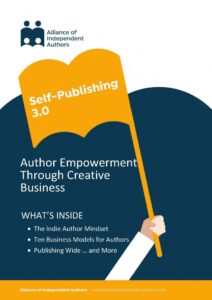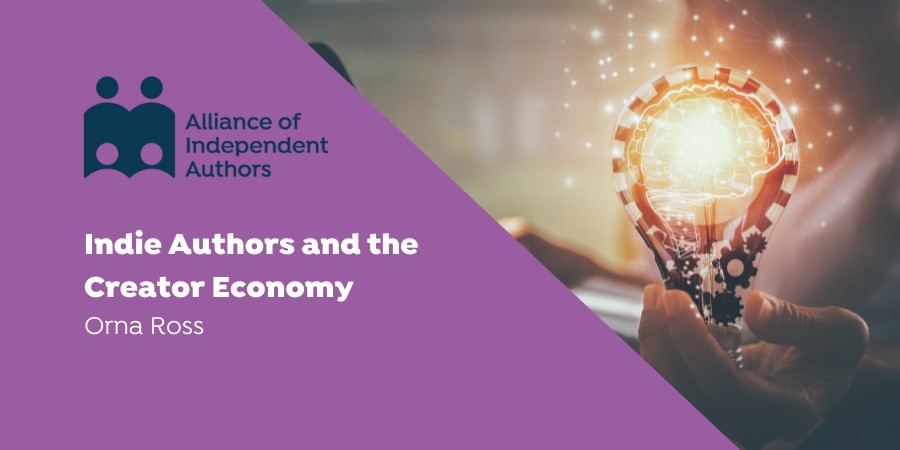
Orna Ross, Director of ALLi
These days, the creative industries, including publishing, are all abuzz about “the creator economy”. In today's post, Alliance of Independent Authors founder Orna Ross takes a closer look at what the creator economy means for indie authors. PLUS: some of the ALLi team predict what other self-publishing trends we can expect in 2022.
The creator economy is the part of the creative economy in which consumers directly fund the work of creators.
Traditionally, publishing was (and corporate publishing still is) very much a B2B (business-to-business) sector. Corporate publishers sell books through wholesalers, distributors and bookstores. Micro-publishing, the sector that contains self-publishing indie authors, is now largely moving to being a B2C (business-to-consumer) sector.
This trend of consumers dealing directly with a source creator is much wider than publishing. The COVID pandemic accelerated the trend. Lockdowns sent those with creative talents searching for new ways to earn a living, while readers and other culture consumers were looking for ways to fill increased leisure hours. In that time of fear and isolation, readers also sought more mindful and personalized experiences online–all great for indie authors.
Today, at the start of 2022, creator run enterprises are now the fastest-growing type of small business across the world, over 50 million people globally call themselves creators, and a recent survey found that more American kids want to be a YouTube star (29%) than an astronaut (11%).
As other sectors struggle and fail post-pandemic, the creator economy is booming, growing from $1.7 billion in 2016 to nearly $14 billion last year. Funded businesses in the creator economy reportedly saw three times as much capital flow last year as in 2020, and many more are bootstrapping their way to success.
Publishing, like music, art and film, is being turned on its head by this trend. All the big social media platforms are currently jumping on (see below) and we are seeing the birth of new publishing platforms, new literary forms, and new genres.
The creator model promises a more human and less automated interaction than social media “influencing” and anonymous online bookselling. “They don’t have to care about fighting against the current of somebody else's platform,” says Sam Yam, the co-founder of Patreon, a pioneer of the creator economy. “It’s value exchanged for creativity.”
Instead of anonymous followers or customers, you have fans, supporters, patrons. You can rely on more dependable income. You can choose which kinds of work you take on, and mould your publishing business around your skills as an author, and your other interests and talents, and the needs of your readers.
Yam predicts a future that replaces social-media giants, and even the creator-economy brands like his own, with individual creators–each with their own custom-built platform.
A creative-powered creator economy.
In theory, this all sounds wonderful but profiting from publishing is as challenging as it ever was.
And wherever there's opportunity, there's competition. As millions of aspiring authors try to build a readership for their work, each niche becomes more competitive than ever. Lower barriers to entry set a higher standard for success.
So what does it mean for indie authors? How much is hype and how much is true opportunity? How do we integrate direct selling to readers with our other writing and publishing tasks?
In short: how do indie authors give ourselves the best chance of success in the creator economy?
The Creator Economy for Indie Authors
Three trends in publishing that started a decade ago are feeding the publishing creator economy:
- the growth in digital publishing: which doesn't just mean ebooks but also digital audiobooks and print-on-demand
- the growth in niche publishing, publishing books for a targeted readership. Now that a global audience is available through digital publishing, almost every niche has enough readers to support a business, if a publisher gets the marketing right. Indeed, the most minority interest can have the most avid readers, who love to sustain their favorite authors by investing not just in their books but in other products and services too.
- the growth in what the book trade calls backlist publishing, continuing to promote old titles rather than only funding the next new book. With digital publishing, books live forever and can be marketed forever.
Indie authors were pioneering in integrating these three into their business structures and have been doing so for more than a decade.
Taken together, these trends create an environment where an author can create a sustainable and scalable business from writing and publishing their own books, even if their topic, or way of writing, is very niche. (This supposes you write and publish well enough to please your readers, of course.).
So self-publishers are well placed to take advantage of the creator economy and again they are leading the field, with today's most ambitious indie authors taking their most loyal readers into their publishing adventures, through patronage, crowdfunding, premium products, as well as selling books directly to them.
At ALLi, we have many members who are completely unknown outside their niche, who do not appear on any bestseller lists but are making a living (and, sometimes, a killing!) from their writing and publishing. Ways in which these authors are earning include:
- Paid subscriptions, memberships and reader clubs
- Tips and donations
- Premium digital content (including NFTs on a choice of blockchains)
- Premium signed physical books
- Other merchandise
- Live and virtual events
- One-to-one interviews
- Masterclasses
- Affiliate programs
- Advertising revenue shares
- Sponsored content
- Product placement
and more.
Indie Authors and the Creator Economy: Social Media Influencers
Social media platforms are central to the creator economy. It's not 100% necessary to be on social media but if you're not, you need to source another way to let people know about your books and get to know, like and trust you.
Many authors are wary of social media and “influencer” culture, much of which can seem crass and superficial to outsiders looking in. Influencers in social media are people (profiles) who have built a reputation for their knowledge and expertise on a specific topic. They make regular posts about that topic on their preferred social media channels and generate followings of enthusiastic, engaged people who pay close attention to their views. Influencers can create trends and guide their followers' purchasing decisions.
Instagram is the social media platform most associated with “influencers”, as it first recognized and developed that marketing space, allowing “influencers” to partner with brands to mutual benefit.
There is overlap in the platforms and publicity methods used by influencers and creators, but they are not the same. The focus for an influencer is on leading purchasing decisions, though earned authority or relationships. The focus for a creator is primarily on making quality content for a defined group of followers or fans. Creators are driven by their passion for the process of creation itself. This makes for a more authentic and deeper connection, but it can also mean the creator is more inclined to neglect the marketing and managerial aspects of the job and can miss out on the commercial rewards their creativity could earn them.
Indie Authors and the Creator Economy: Social Media Platforms
The success of the creator economy has ignited interest from social media platforms. Ad-driven platforms like Facebook and Twitter have long profited from user's content and our follower attention, without giving much back.
Now they are recognizing that it is creators' collective efforts that makes their platforms compelling (aka profitable), and they are moving from selling ads based on over-all views and likes to encouraging creators and setting up ways they can be paid by followers.
- Facebook, which also owns Instagram, allows any creator to set up shop and guides purchasers to the creator's shop to purchase. They recently announced $1 billion in investments to reward creators on the platforms in 2022
- TikTok now has a creator fund to pay its users directly for popular content
- Twitter has rolled out its tip jar for creators, with bitcoin option
- Youtube's partner program pays out 68% of ad revenue to creators
As competition between the platforms intensifies, it's good news for authors and other content creators.
“We want to build the best platforms for millions of creators to make a living,” Mark Zuckergberg recently said in a Facebook post about rewarding creators, especially those just starting out. Their new bonus program pays those who are eligible for hitting certain milestones when they use Facebook’s tools.
The platform also intends to provide seed funding for creators to produce their own content.
Indie Authors and the Creator Economy: Purpose Built Platforms
In addition to the established social media platforms, all sorts of services are now popping up to serve authors in the creator economy.
- Subscription-driven platforms like Substack (for non-fiction), Radish (for fiction), Podia and Teachable (for courses) and Patreon (for everthing) provide platform that publish and paywalls content on a membership basis.
- Free platforms like Webtoon, Tapas, or Wattpad now have premium programs that pay writers.
- Buy Me a Coffee and Paypal donation buttons also allow a one off tip without creating an account,
- Audio social networks like Clubhouse allow authors and readers around the world to come together to talk, listen and learn from each other in real time
- Twitch and Heygo live-streaming platforms provide a virtual proxy for readings and other events. Viewers can access video streams for free, with the option to send tips to the hosts, buy a book etc
- Memberful, MemberMouse and other membership software allow indie authors to sell memberships to their audience on their own websites
- Linktree, Beacons, and Feedlink expands website links in the bios of social-media accounts, directing readers to your website, social media, and book purchase channels
- Crowdfunding sites like Kickstarter now have publishing sections and publishing crowfunders like Unbound specialise in books
Don't license rights to anybody who is not investing in your work. Never sign away all rights: instead limit term, territory and format.
Please contact the ALLi Watchdog desk if in doubt about these service agreements and any self-publishing agreement.
Indie Authors and the Creator Economy: Owned Platforms
 While creators now have countless tools to build and access audiences, for the most part, they don’t own them.
While creators now have countless tools to build and access audiences, for the most part, they don’t own them.
The platforms are investing in creators at the moment, because they are competing with each other to keep consumers on their platforms, which keeps their ad revenue up. Creators help them to do that.
Will the time come when they charge us for the “privilege” of having a store on their platform? Perhaps. Setting up shop on somebody else's platform e.g. Facebook or Amazon, leaves us vulnerable to unforeseen policy changes, algorithm updates and closed-off networks.
Self-Publishing 3.0, which is part of Web 3.0 promises more control in the hands of authors. Keeping to the core business principles outlined below will mean you won't be caught out, should any one provider change their terms.
It's your responsibility to ensure that you don't follow your passion for writing into poverty. The platforms are in business, making businesslike decisions. So are you, and so should you.
Anchoring our brand to our own, owned channels allows us to build communities that are truly ours. If being an indie author means anything, it means protecting our independence.
Indie Authors and the Creator Economy: Ten Tips for Success
Success is not just about racking up profits, but doing so in a way that also feeds your passion. Here are ten tips for succeeding in the indie author creator economy, creatively as well as commercially.
Creator Economy for Indie Authors 1: Value Yourself
Making a living in the creator economy means asking for money, being humble enough to make the ask.
People always take you at face value and will pay you in the currency you ask for. Ask only for clicks and likes, and that's all you'll get. Use your Facebook ads to bring people to Amazon and that's where they'll stay. The successful creator makes their own website or app their main platform. The others are satellites, all pointed back towards that home base.
Think about social media platforms like Facebook and Twitter, and publishing platforms like Amazon and Apple as ways to bring people across. Use social media and publishing platforms to grow your readership and mailing lists by always guiding them towards your own website to purchase.
Some signs that you value yourself:
- You make sure you are charging enough for your books and other products to pay your team and yourself properly
- You keep a laser focus on return-on-investment (not just costs)
- You only offer free stuff as part of a logical strategy
- You pay yourself first
- You make a profit
Don't worry if you're not there yet. If you're not, the important thing is to feel the discomfort around these issues, listen to your self-talk about them, determine to grow and value yourself more.
Creator Economy for Indie Authors 2: Value Your Readers
To create a strong bond, you must understand your readers and what they value. Social media analytics and reader reviews offer quantitative and qualitative data that help you to understand where your readership is coming from, what they like, and what you should offer. When you know what your readers value, give it to them, consistently. Again, observe any resistance that rises around this.
Creator Economy for Indie Authors 3: Do Things Your Own Way
Keep looking at what others are doing in the same field and what new things you can do too. Indie authors often play follow the leader. It's good to learn from others but don't get lost in the crowd playing copycat. Readers respond well to difference. Exaggerate your appeal. Develop your unique style, in your books and beyond. Be contrarian. Stir hype. Go creative!
Creator Economy for Indie Authors 4: Ditch Comparisonitis
Don't get enthralled by others’ success. You'll never know their full story, their background, advantages, hard work, struggles–and it doesn't matter anyway. Look at what others are doing to learn, not to compare.
Creator Economy for Indie Authors 5: Stay Consistent
Consistently creating good content is how you increase your following and engagement. Make it your intention to learn and grow through regular content creation and feedback.
Creator Economy for Indie Authors 6: Keep Improving
Work on your craft– your writing craft and your publishing craft.
Creator Economy for Indie Authors 7: Readers First (brand deals second)
Reputation and reader trust are your most powerful assets. When you become visible online, you soon find brands reaching out for collaboration. If that's what you fancy, great! But before accepting any deal, do your research. Only collaborate if you can integrate this brand authentically into your mission. Understand the advantages and disadvantages of association (there are always disadvantages, it's always a matter of balance).
Creator Economy for Indie Authors 8: Create a Team
Like all players in the creative economy, indie authors need time for creative rest and play, time to explore and experiment, time to interact authentically with followers and fans, while also writing and publishing new books.
This breaks down into lots of tasks, some of which you are best placed to do but many of which are better delegated to others, and some of which call for expertise you can't have and must be outsourced, e.g. editing or design.
A good book is always a team effort. The cumulative effect of multiple minds is better than one mind working on numerous things. Identify what only you can do, source good team members and delegate wherever possible.
Creator Economy for Indie Authors 9: Simplify and Delete
Our business is complex and often we do things that have little value. Be rigorous. If something isn't getting results, drop it. Go core. Delete all busy work and only do value work.
Creator Economy for Indie Authors 10: Take Care of Yourself
Indie authors work hard, put our hearts and souls into our jobs, and put ourselves out there. It's challenging, especially when our books get poor reviews, or when our hype or success triggers social media hate.
Creative work can be an act of self-love but it can also turn into the opposite: a stick to beat yourself down. The fast-paced nature of social media and publishing schedules puts authors at risk of burnout. It's not necessary, or productive, for a creative to overwork. Working well rather than hard is optimal.
To play a long-term game as a creative, you must have your own tried-and-tested outlet for creative anxiety and stress. You must know how to take care of yourself. You must factor time for creative rest and play and work.
At its most fundamental, this means valuing and looking after your mental and physical health. Which brings us back to our first point: valuing yourself.
For more on the creative economy, Orna Ross is running a workshop that explores alternative earnings for authors on Friday next.
Self-Publishing in 2022: Other Predictions
As ever, there will be lots of other things happening in the self-publishing space in 2022. It's customary for us to make predictions for the year to come in January (Here are the links to the last two year's predictions: 2020 was also a prediction for the decade to come, and here's what we predicted in 2021. ) Below three members of the ALLi team consider some of what's coming down the track for indie authors in 2022.

Michael LaRonn, Author and ALLi Outreach Manager
Michael LaRonn Member Q&A Podcast Co-Host and Outreach Manager
“2022 will be an interesting year. I am watching a few things closely. First, AI narration for audio appears to finally be a viable option for nonfiction. Combine that with the seismic changes that have happened in the audiobook market over the final months of 2021, and I believe we could be on the cusp of several watershed moments in terms of how authors bring audiobooks to the market.Second, the effects of inflation are hitting writers and readers in every area of their lives…except with book prices. Should authors raise their prices? Will retailers like Amazon shift prices slightly upward to account for inflation? On one hand, you can make an argument to keep book prices low as a refuge for readers. But on the other hand, that doesn’t give writers much help in these crazy times—after all, the costs of cover design in particular are on the rise. It will cost more money to produce a book in 2022 than it ever did in 2014. The value of a $2.99 commission just isn’t as powerful as it used to be, and we’re only talking an 18-month period. More people are starting to talk about this and debate it, and I’m curious where we’ll be a year from now. Authors are understandably cost-conscious right now.Third and finally, AI-assisted writing tools seem to be on the rise, and I foresee more conversations happening on that front. In any case, I felt that 2021 was a much better year than 2020, and I hope 2022 will continue to take us in a better direction for our careers.”

ALLi News Editor Dan Holloway
Dan Holloway Self-Publishing News Editor
“The biggest news story of 2021 came in November, when Spotify bought Findaway, so I expect the repercussions of that to ripple throughout 2022. I don't expect we'll know for sure whether it marks the start of a land of opportunity for us or the beginning of the end of meaningful payment for audiobooks, but we should at least have an idea.
I also expect artificial intelligence to come up with voice narration that's not only good but genuinely indistinct from human narration. Again, whether this is an opportunity or part of how the creative industries change for the worse forever is unlikely to be clear within a year.
Publishing has committed to tackling climate change en masse. I wonder if this might mean 2022 is a year in which more traditional publishers turn to print on demand, where printing is more local to customers and there are no, or fewer, returns. This could either level the playing field and mean better facilities are built that we all benefit from, or it could see indies competing for printing facilities with traditional publishers.”

ALLi Special Projects & UK Ambassador Debbie Young
Debbie Young Special Projects & UK Ambassador
Indies have known for a long time that it's possible and probable to make more money pricing ebooks at much lower prices than print, because then they are likely to sell more copies. If the big trade publishers get on that wagon, it will not only add competition for lower-priced indie books, but it could also hugely undermine the brick-and-mortar stores that the archaic physical book ecosystem is designed to sustain. Bookshops have never been good at selling ebooks or even ereaders, and have largely abandoned them, which frankly was no surprise – what physical stores do best is to sell beautiful print editions, with “puppy-dog selling” techniques – ie the reader gets to pick up, examine, stroke the products, which makes them far more likely to buy. Stores are also underpinned by the sale-or-return mechanism, allowing them to buy new books on the basis they can return them to the publisher for full credit, and Dan Holloway has already addressed in a recent news report the inherent waste that this leads to, with returned books generally being pulped.Which leads me onto another environmental issue related to paper costs – how come when we've all been striving over the last decade or so to save trees by not wasting paper, has the book industry become so profligate with paper? (Although that's always seemed a spurious argument to me because surely the trees used to make paper are purpose grown, and would not be grown otherwise? – I'm not sure printers go felling rainforests for book paper… but I digress!)It's become increasingly commonplace to bulk up print books with bigger margins, larger print, and wider line-spacing, and to have more and more pages in the front and back matter. The cynic in me suspects this is done primarily to make a book look better value for money, eg spinning out a novella to look like a chunky novel. I appreciate book production qualities become higher and the end products more beautiful with each passing year, but isn't there a huge disconnect between this attitude and modern environmental goals? I think there is an opportunity for indies to lead the way here – as we do with so many other aspects of publishing – by repackaging our print books to be far less wasteful.This can be done without making books less attractive and less readable. We have a vast array of fonts at our disposal, and narrower margins and less leading, once our eyes were attuned to them, would still be perfectly legible. We could be less wasteful of front and back matter – why do we still persist in having half-title pages, which were necessary in the early days of print but aren't needed with digital presses. (Definition of half title page). Do we need so much back matter? Do we really need to start each chapter on a new page, or even on a right-hand only page? (An old-fashioned habit which I confess I've done in my books until now because I like it, but I shan't be doing that in future books.)You have only to look at the books printed during the Second World War to see how much slimmer books can be when paper was strictly rationed. The paper is lighter, with very narrow margins and small print, yet made durable with hardback covers. I collect war-time editions of old favourites because I positively enjoy reading them, not least because they are so much more lightweight and easy to hold and to carry around than the same book in 21st century paperback. Of course it is still important to produce large print and dyslexia-friendly books for those who need them, but those are a small minority of readers. As an industry, we can make a significant different to our carbon (and tree) footprint by rationing ourselves. We could also revert to smaller formats – lots of trade publishers produce huge paperbacks initially, before going on to smaller mass market runs later in the life of a book. Are this ginormous tomes really worth their environmental footprint?I realise a lot of publishers (including indies) may be loath to sacrifice the look of a book – and therefore its customer appeal and competitiveness – for environmental benefits, but I'm calling Emperor's New Clothes on this one. Will I be a lone voice in the new year? Time will tell…”





My daughter and I write a chapter book series for children; we’re newbies with two books published and the third underway. You’ve given us lots to think about. Thanks, very much, for all the work that went into researching and writing this post.